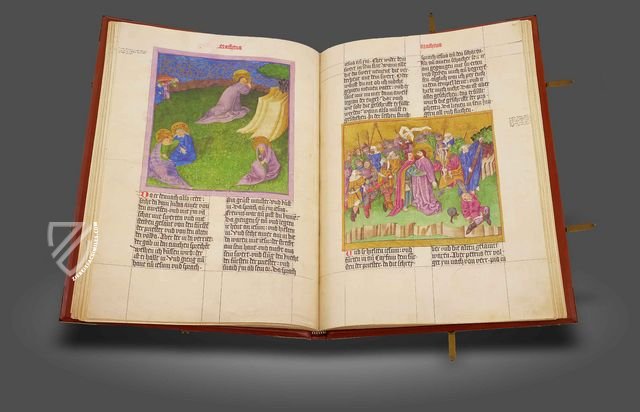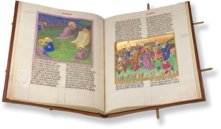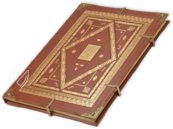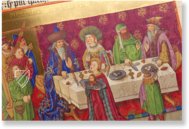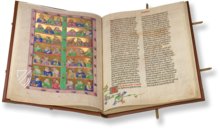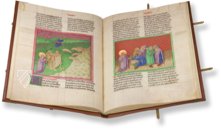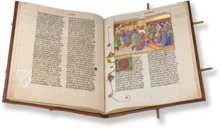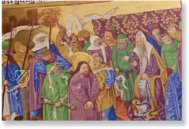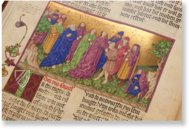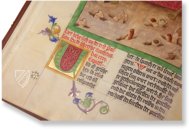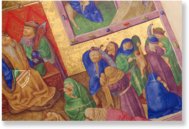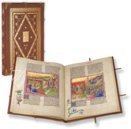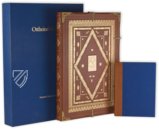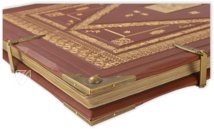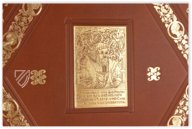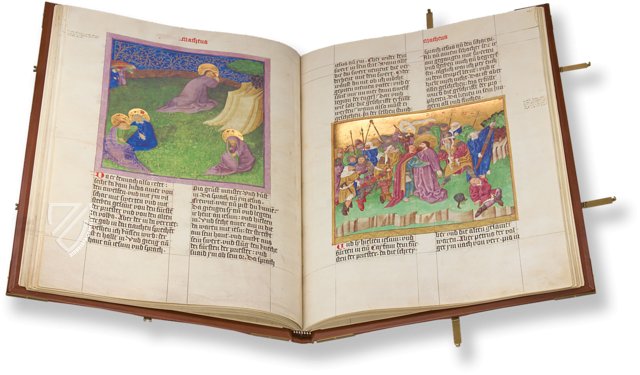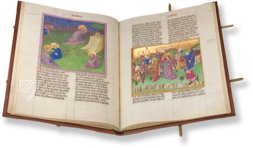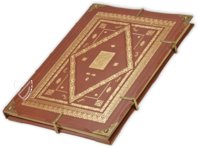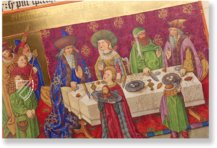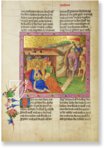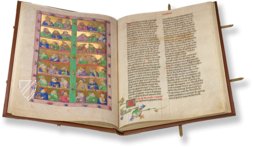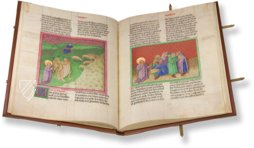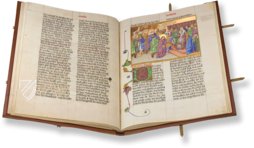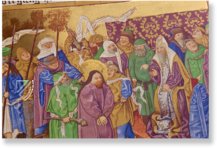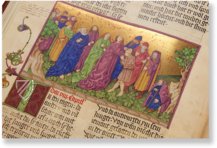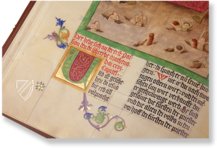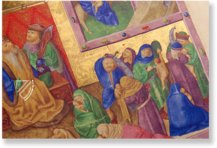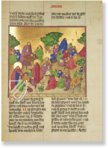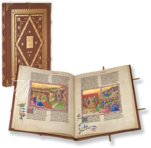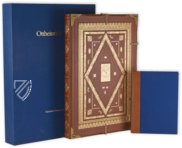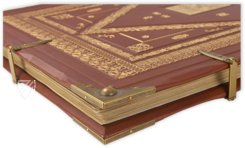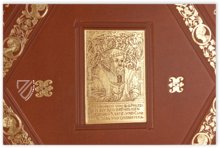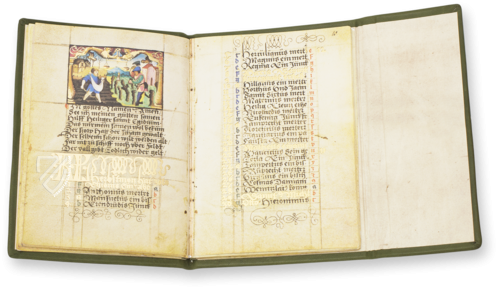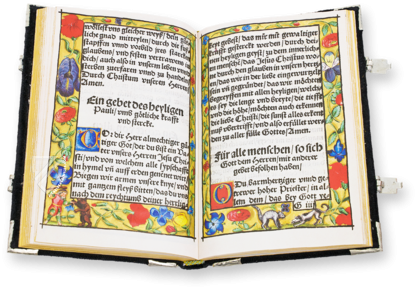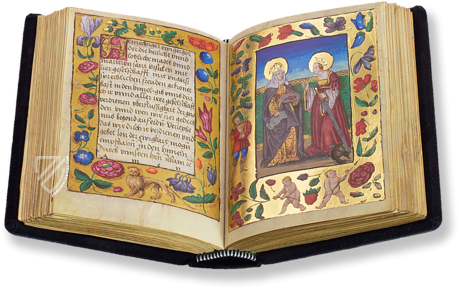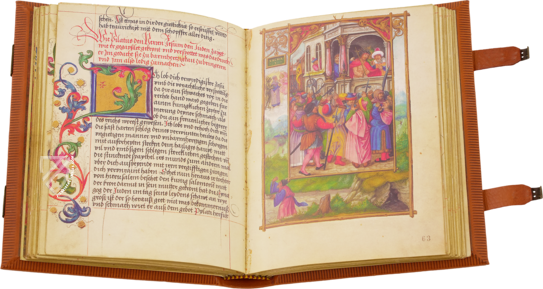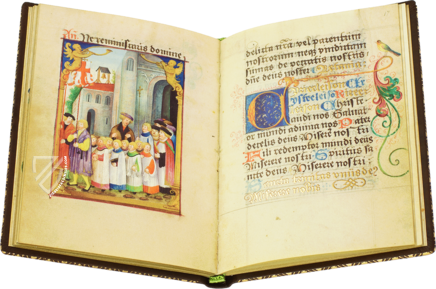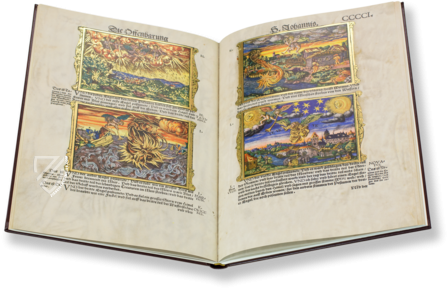Ottheinrich's Bible
(1,000€ - 3,000€)
Work began on “first illustrated New Testament edition in German” ca. 1430 in Regensburg. The rich ornamentation of manuscript originates from the hands of several important masters of the “Regensburg School” of the 14th century and was completed 100 years later in the style of the German Renaissance. The enigma of the work’s patron was only solved a few years ago, with sources pointing to Duke Ludwig “the Bearded” of Bavaria-Ingolstadt. The Ottheinrich Bible is currently housed in Munich and the highly coveted manuscript has had quite the checkered past in terms of ownership. 46 half- or full-page miniatures with luminous golden backgrounds and vivid, eye-catching colors made from the most expensive materials. The text, neatly written in two columns, is adorned by 41 brushed gold initials and countless smaller initials in red ink.
Ottheinrich’s Bible
Named after its traceable owner, the Ottheinrich Bible is the oldest preserved German language edition of the New Testament. Next to the German text, the manuscript distinguishes itself above all because of its illumination. The work originates from several important masters of the Regensburg School during the 14th century and was fully completed 100 years later with the creation of the furnishings by Matthias Gerung in the style of the German Renaissance. The checkered ownership history of the bible testifies to its unique place in Art History.
The First Illustrated New Testament in German
As opposed to the Latin version of the bible, which could only be read by highly educated people and the clergy, the Ottheinrich Bible is written in New High German and was therefore understandable to a layperson. The 46 half- or full-page miniatures shine through the application of expensive materials, e.g. the golden backgrounds or the vivid, eye-catching colors, which are made for the most part with equally expensive mineral and other materials like azure or magenta. Next to the panel-painting-like primary images, which illustrate the biblical text, one cannot help but be fascinated by the sweeping and skillfully draped tendrils, which appear more commonly at the beginning and then less often later on, and artfully designed colored or gilded initials. With regard to the artists of the older illumination, three different masters can be distinguished, who most certainly worked on this Bible in Regensburg. Some originated from the so-called Salzburg Studio of the Grillinger Bible and from the circle of the important Masters of the Worchester Carrying of the Cross. The work of these artists is limited to the Gospel of Mark. The painter Matthias Gerung was primarily responsible for the greater part of the interior of the manuscript. He oriented his work on the greatest works of his time. Thus, his Apocalypse miniatures were directly influenced by Albrecht Dürer’s woodcarvings.
The Enigmatic Patron
The patron of the Ottheinrich Bible was only recently determined to be Duke Ludwig “the Bearded” of Bavaria-Ingolstadt. Before his rule, he spent a long time in the French court with his sister Elizabeth, the French Queen Isabella of Bavaria. In a leafy border of the book, a French motto is incorporated, which became a trademark for him. Mysteriously, the manuscript was never completed during the lifetime of Ludwig, but was still bound for the most part.
A Checkered Past of Ownership
Ludwig’s inheritance would be passed down through the Landshut branch of the Wittelsbach family, and thereby came into the possession of Count Palatine Ottheinrich, who would lend it his name. The book was later sent to Neuburg an der Donau and finally to Heidelberg. It was Ottheinrich who commissioned Matthias Gerung to complete the book. During the confusion of the 30 Years War, the book was brought to Munich in 1622 as war booty by the Prince Elector Maximillian I of Bavaria, from whence it was subsequently taken in 1632 by invading Swedes to Weimar and finally to Gotha. The Ottheinrich Bible remained in Gotha for the next three hundred years and was a highlight of their collection known as the Gothaic Bible. In the 19th century, the book was parted into eight pieces and ended up in the 20th century in two parts; one half ended up in Heidelberg and the other in Munich’s Bavarian State Library in the course of the 20th century. The empty cover remained in Gotha. Only in 2007 were all the individual parts of the Ottheinrich Bible brought back together through the spectacular acquisitions effort and generous donations and today calls the Bavarian State Library home.
Codicology
- Alternative Titles
- Ottheinrich-Bibel
Gothaer Bibel - Size / Format
- 616 pages / 53.2 × 37.2 cm
- Origin
- Germany
- Date
- 1425–1430 and ca. 1530
- Epochs
- Style
- Genre
- Language
- Illustrations
- 46 miniatures on a gold leaf background, 41 brushed gold initials
- Artist / School
- Salzburg Grillinger Bible workshop, Master of the Worcester Crucifixion, Mattias Gerung, and others
- Previous Owners
- Count Palatine Ottheinrich (1502–1559)
Munich Court Library
Ottheinrich's Bible
Feeding the Five Thousand
As Passover drew near, Jesus came to the Sea of Galilee with his disciples where they were confronted with a logistical problem: how to feed his five thousand followers assembled there. This golden miniature shows the commotion of the crowd: “And when He had taken the five loaves and the two fish, He looked up to heaven, blessed and broke the loaves, and gave them to His disciples to set before them; and the two fish He divided among them all. So they all ate and were filled.” (Mk. 6:41-42)
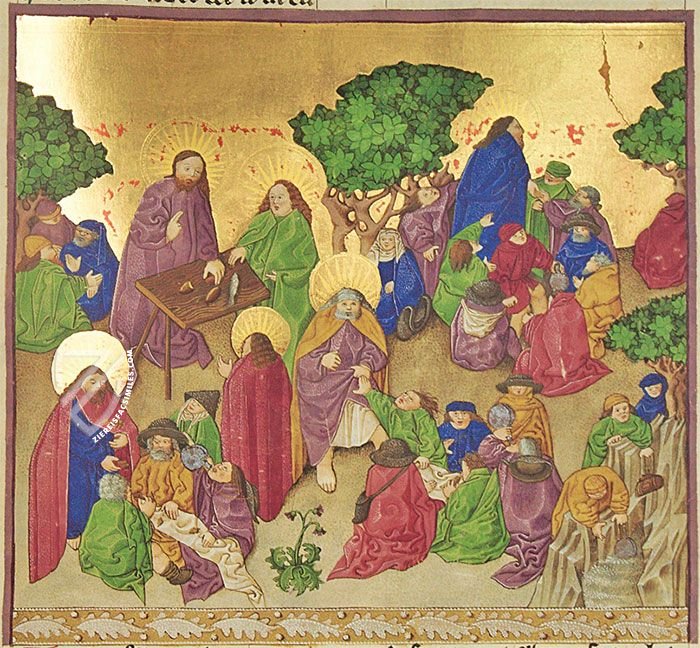
Ottheinrich's Bible
The Adoration of the Magi
This is just a taste of this precious and coveted manuscript’s unbelievably rich illumination. A pink frame studded with precious jewels mounted in gold fittings surrounds this beloved scene. The background consists of burnished gold that has not only been engraved with a tendril pattern, but is further adorned with blue and red leaves.
Mary and Joseph are pictured wearing crowns and luxurious robes, they and the rest of the figures are dressed in the fashion of 15th century nobility. Curiously, Mary has a halo, but neither her husband nor her blessed son do. Dressed in a red cloak beautifully patterned with cloth of gold, one of the Magi kneels before the Holy Family, presenting them with a gift as the rest of his entourage looks on.
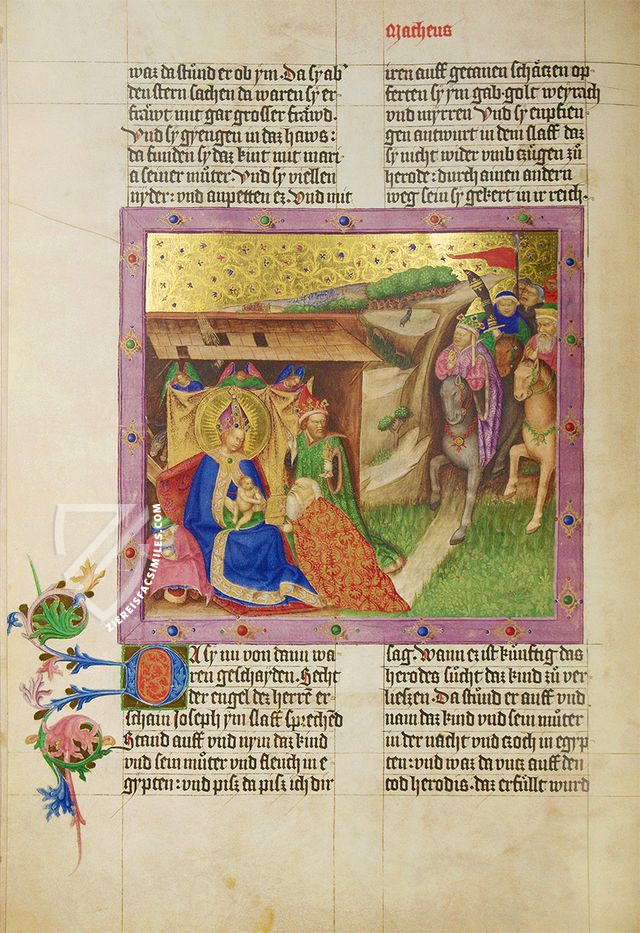
#1 Ottheinrich-Bibel
Language: German
(1,000€ - 3,000€)
- Treatises / Secular Books
- Apocalypses / Beatus
- Astronomy / Astrology
- Bestiaries
- Bibles / Gospels
- Chronicles / History / Law
- Geography / Maps
- Saints' Lives
- Islam / Oriental
- Judaism / Hebrew
- Single Leaf Collections
- Leonardo da Vinci
- Literature / Poetry
- Liturgical Manuscripts
- Medicine / Botany / Alchemy
- Music
- Mythology / Prophecies
- Psalters
- Other Religious Books
- Games / Hunting
- Private Devotion Books
- Other Genres
- Afghanistan
- Armenia
- Austria
- Belgium
- Belize
- Bosnia and Herzegovina
- China
- Colombia
- Costa Rica
- Croatia
- Cyprus
- Czech Republic
- Denmark
- Egypt
- El Salvador
- Ethiopia
- France
- Germany
- Greece
- Guatemala
- Honduras
- Hungary
- India
- Iran
- Iraq
- Israel
- Italy
- Japan
- Jordan
- Kazakhstan
- Kyrgyzstan
- Lebanon
- Liechtenstein
- Luxembourg
- Mexico
- Morocco
- Netherlands
- Palestine
- Panama
- Peru
- Poland
- Portugal
- Romania
- Russia
- Serbia
- Spain
- Sri Lanka
- Sweden
- Switzerland
- Syria
- Tajikistan
- Turkey
- Turkmenistan
- Ukraine
- United Kingdom
- United States
- Uzbekistan
- Vatican City
- A. Oosthoek, van Holkema & Warendorf
- Aboca Museum
- Ajuntament de Valencia
- Akademie Verlag
- Akademische Druck- u. Verlagsanstalt (ADEVA)
- Aldo Ausilio Editore - Bottega d’Erasmo
- Alecto Historical Editions
- Alkuin Verlag
- Almqvist & Wiksell
- Amilcare Pizzi
- Andreas & Andreas Verlagsbuchhandlung
- Archa 90
- Archiv Verlag
- Archivi Edizioni
- Arnold Verlag
- ARS
- Ars Magna
- ArtCodex
- AyN Ediciones
- Azimuth Editions
- Badenia Verlag
- Bärenreiter-Verlag
- Belser Verlag
- Belser Verlag / WK Wertkontor
- Benziger Verlag
- Bernardinum Wydawnictwo
- BiblioGemma
- Biblioteca Apostolica Vaticana (Vaticanstadt, Vaticanstadt)
- Bibliotheca Palatina Faksimile Verlag
- Bibliotheca Rara
- Boydell & Brewer
- Bramante Edizioni
- Bredius Genootschap
- Brepols Publishers
- British Library
- C. Weckesser
- Caixa Catalunya
- Canesi
- CAPSA, Ars Scriptoria
- Caratzas Brothers, Publishers
- Carus Verlag
- Casamassima Libri
- Centrum Cartographie Verlag GmbH
- Chavane Verlag
- Christian Brandstätter Verlag
- Circulo Cientifico
- Club Bibliófilo Versol
- Club du Livre
- CM Editores
- Collegium Graphicum
- Collezione Apocrifa Da Vinci
- Comissão Nacional para as Comemorações dos Descobrimentos Portugueses
- Coron Verlag
- Corvina
- CTHS
- D. S. Brewer
- Damon
- De Agostini/UTET
- De Nederlandsche Boekhandel
- De Schutter
- Deuschle & Stemmle
- Deutscher Verlag für Kunstwissenschaft
- DIAMM
- Droz
- E. Schreiber Graphische Kunstanstalten
- Ediciones Boreal
- Ediciones Grial
- Ediclube
- Edições Inapa
- Edilan
- Editalia
- Edition Deuschle
- Edition Georg Popp
- Edition Leipzig
- Edition Libri Illustri
- Editiones Reales Sitios S. L.
- Éditions de l'Oiseau Lyre
- Editions Medicina Rara
- Editorial Casariego
- Editorial Mintzoa
- Editrice Antenore
- Editrice Velar
- Edizioni Edison
- Egeria, S.L.
- Eikon Editores
- Electa
- Emery Walker Limited
- Enciclopèdia Catalana
- Eos-Verlag
- Ephesus Publishing
- Ernst Battenberg
- Eugrammia Press
- Extraordinary Editions
- Fackelverlag
- Facsimila Art & Edition
- Facsimile Editions Ltd.
- Facsimilia Art & Edition Ebert KG
- Faksimile Verlag
- Feuermann Verlag
- Folger Shakespeare Library
- Franco Cosimo Panini Editore
- Friedrich Wittig Verlag
- Fundación Hullera Vasco-Leonesa
- G. Braziller
- Gabriele Mazzotta Editore
- Gebr. Mann Verlag
- Gesellschaft für graphische Industrie
- Getty Research Institute
- Giovanni Domenico de Rossi
- Giunti Editore
- Graffiti
- Grafica European Center of Fine Arts
- Guido Pressler
- Guillermo Blazquez
- Gustav Kiepenheuer
- H. N. Abrams
- Harrassowitz
- Harvard University Press
- Helikon
- Hendrickson Publishers
- Henning Oppermann
- Herder Verlag
- Hes & De Graaf Publishers
- Hoepli
- Holbein-Verlag
- Houghton Library
- Hugo Schmidt Verlag
- Idion Verlag
- Il Bulino, edizioni d'arte
- ILte
- Imago
- Insel Verlag
- Insel-Verlag Anton Kippenberger
- Instituto de Estudios Altoaragoneses
- Instituto Nacional de Antropología e Historia
- Introligatornia Budnik Jerzy
- Istituto dell'Enciclopedia Italiana - Treccani
- Istituto Ellenico di Studi Bizantini e Postbizantini
- Istituto Geografico De Agostini
- Istituto Poligrafico e Zecca dello Stato
- Italarte Art Establishments
- Jan Thorbecke Verlag
- Johnson Reprint Corporation
- Josef Stocker
- Josef Stocker-Schmid
- Jugoslavija
- Karl W. Hiersemann
- Kasper Straube
- Kaydeda Ediciones
- Kindler Verlag / Coron Verlag
- Kodansha International Ltd.
- Konrad Kölbl Verlag
- Kurt Wolff Verlag
- La Liberia dello Stato
- La Linea Editrice
- La Meta Editore
- Lambert Schneider
- Landeskreditbank Baden-Württemberg
- Leo S. Olschki
- Les Incunables
- Liber Artis
- Library of Congress
- Libreria Musicale Italiana
- Lichtdruck
- Lito Immagine Editore
- Lumen Artis
- Lund Humphries
- M. Moleiro Editor
- Maison des Sciences de l'homme et de la société de Poitiers
- Manuscriptum
- Martinus Nijhoff
- Maruzen-Yushodo Co. Ltd.
- MASA
- Massada Publishers
- McGraw-Hill
- Metropolitan Museum of Art
- Militos
- Millennium Liber
- Müller & Schindler
- Nahar - Stavit
- Nahar and Steimatzky
- National Library of Wales
- Neri Pozza
- Nova Charta
- Oceanum Verlag
- Odeon
- Orbis Mediaevalis
- Orbis Pictus
- Österreichische Staatsdruckerei
- Oxford University Press
- Pageant Books
- Parzellers Buchverlag
- Patrimonio Ediciones
- Pattloch Verlag
- PIAF
- Pieper Verlag
- Plon-Nourrit et cie
- Poligrafiche Bolis
- Presses Universitaires de Strasbourg
- Prestel Verlag
- Princeton University Press
- Prisma Verlag
- Priuli & Verlucca, editori
- Pro Sport Verlag
- Propyläen Verlag
- Pytheas Books
- Quaternio Verlag Luzern
- Reales Sitios
- Recht-Verlag
- Reichert Verlag
- Reichsdruckerei
- Reprint Verlag
- Riehn & Reusch
- Roberto Vattori Editore
- Rosenkilde and Bagger
- Roxburghe Club
- Salerno Editrice
- Saltellus Press
- Sandoz
- Sarajevo Svjetlost
- Schöck ArtPrint Kft.
- Schulsinger Brothers
- Scolar Press
- Scrinium
- Scripta Maneant
- Scriptorium
- Shazar
- Siloé, arte y bibliofilia
- SISMEL - Edizioni del Galluzzo
- Sociedad Mexicana de Antropología
- Société des Bibliophiles & Iconophiles de Belgique
- Soncin Publishing
- Sorli Ediciones
- Stainer and Bell
- Studer
- Styria Verlag
- Sumptibus Pragopress
- Szegedi Tudomànyegyetem
- Taberna Libraria
- Tarshish Books
- Taschen
- Tempus Libri
- Testimonio Compañía Editorial
- Thames and Hudson
- The Clear Vue Publishing Partnership Limited
- The Facsimile Codex
- The Folio Society
- The Marquess of Normanby
- The Richard III and Yorkist History Trust
- Tip.Le.Co
- TouchArt
- TREC Publishing House
- TRI Publishing Co.
- Trident Editore
- Tuliba Collection
- Typis Regiae Officinae Polygraphicae
- Union Verlag Berlin
- Universidad de Granada
- University of California Press
- University of Chicago Press
- Urs Graf
- Vallecchi
- Van Wijnen
- VCH, Acta Humaniora
- VDI Verlag
- VEB Deutscher Verlag für Musik
- Verlag Anton Pustet / Andreas Verlag
- Verlag Bibliophile Drucke Josef Stocker
- Verlag der Münchner Drucke
- Verlag für Regionalgeschichte
- Verlag Styria
- Vicent Garcia Editores
- W. Turnowski Ltd.
- W. Turnowsky
- Waanders Printers
- Wiener Mechitharisten-Congregation (Wien, Österreich)
- Wissenschaftliche Buchgesellschaft
- Wissenschaftliche Verlagsgesellschaft
- Wydawnictwo Dolnoslaskie
- Xuntanza Editorial
- Zakład Narodowy
- Zollikofer AG

